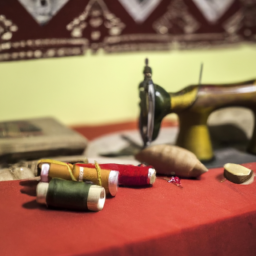
History of the Sewing Needle
The Invention of a Timeless Tool
Sewing, one of the oldest textile arts, has been an integral part of human civilization for thousands of years. At the heart of this craft lies a simple yet ingenious tool – the sewing needle.
Early Needles: From Bone to Metal
The early sewing needles were made of bones or ivory, typically crafted by our resourceful ancestors. These basic, functional tools enabled the primitive men and women to stitch together animal skins for clothing, survival gear, and even shelter.
Throughout history, various materials were used to create sewing needles. From animal bones to copper, bronze, and iron, the needle significantly evolved with the progress of metallurgy. The Iron Age, in particular, ushered in a new era of needle production, with iron needles becoming widely popular across the world.
The Middle Ages and the Renaissance
During the Middle Ages, sewing needles continued to be made from iron, with shafts becoming thinner and sharper. Needle production became a specialized craft, and skilled blacksmiths were sought after for creating high-quality needles.
With the advent of the Renaissance, needle-making techniques expanded, leading to the development of finer and more delicate needles. These needles often featured gold or silver handles adorned with intricate designs, reflecting the opulence of the time.
Industrial Revolution and Mass Production
The Industrial Revolution in the 18th century revolutionized many industries, including needle manufacturing. The introduction of automated machinery made possible the large-scale production of sewing needles, leading to a significant decrease in their cost.
With the establishment of industrial needle factories, a wider range of needle types emerged, catering to specific sewing purposes. Needle production became faster, more efficient, and cheaper, making sewing accessible to people from all walks of life.
Modern Needles: Innovation and Diversification
In the 20th century, manufacturing techniques continued to advance, resulting in further innovation in needle design and materials. Stainless steel needles, which were stronger, more durable, and rust-resistant, gained popularity.
Today, sewing needles come in various types, sizes, and shapes to meet the diverse needs of sewers worldwide. From embroidery to leatherwork, quilting to upholstery, there is a specialized needle for every task. Needles with built-in threading mechanisms and ergonomic handles have also been developed to enhance the sewing experience.
The Sewing Needle’s Enduring Impact
The history of the sewing needle is a testament to human ingenuity and the desire for craftsmanship. From its humble beginnings as a bone tool to its modern, technologically-enhanced forms, the sewing needle has played an indispensable role in the development of textiles, fashion, and the very fabric of our societies.





Interesting!
Fabulous find! It’s amazing to see how far this essential tool has advanced through the years – an interesting look into the past!
Absolutely fascinating!
Intriguing!